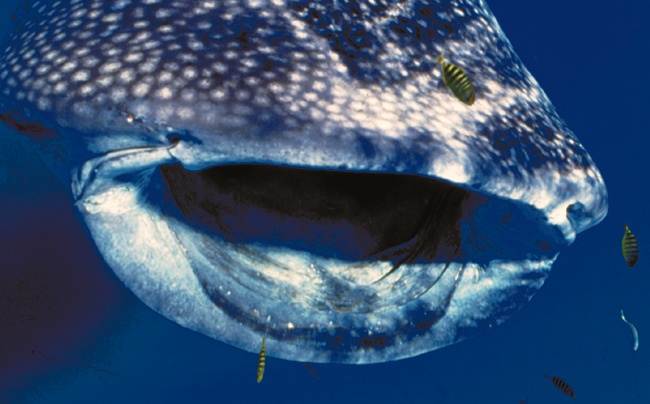Competition or Cooperation
How Symbiosis Defies Darwin

A serious obstacle to evolutionary theory is the interdependent relationships between living things, called symbiosis, in which completely different forms of life depend on each other to exist.
Darwin's theory of biological change was based on competition, or survival of the fittest, among the individuals making up a species. He admitted: "If it could be proved that any part of the structure of any one species had been formed for the exclusive good of another species, it would annihilate my theory, for such could not have been produced through natural selection" (The Origin of Species, 1859, Masterpieces of Science edition, 1958, p. 164).
Symbiotic relationships pose such a challenge to Darwin's theory, since they have animals and plants of different species cooperating for the benefit of both. Evolutionists call this coadaptation, but they have yet to come up with a plausible explanation of how such relationships could have evolved in stages.
How can plants that need certain animals to survive have existed before those animals appeared in the first place? And how do animals that need other animals to survive arrive without their partners arriving at the exact same moment?
Symbiosis among lower forms of life
One example of beneficial symbiosis (called mutualism) is that found between algae and the fungus of lichens. While fungi provide vital protection and moisture to algae, the algae nourish the fungi with photosynthetic nutrients that keep them alive. As a biology textbook puts it: "Neither population could exist without the other, and hence the size of each is determined by that of the other" (Mary Clark, Contemporary Biology, 1973, p. 519).
So which came first, the alga or the fungus? Since neither could exist without the other, according to evolution for both to survive they had to evolve independently of each other, yet appear at exactly the same time and with precisely the right functions.
How could two completely different species evolve separately from distinct ancestors, yet depend on each other to exist? Frankly, the idea that this relationship evolved is utterly beyond reason.
Symbiosis between plants and animals
Consider next the relationship between bees and plants.
While collecting the precious nectar that provides their hives with food, bees pollinate dozens of species of flowers and agricultural crops. Without this vital pollination, orchards could produce little if any fruit, and fruit trees would not survive for long. How can these plants exist without first being pollinated by bees? On the other hand, how could bees exist without first being provided with the necessary nectar as food?
In addition, the bee has to carry out pollination in a precisely specific way for the process to work. If the bee visited other species of flowers at random, pollination could not occur, since the pollen of one species of flower does not fertilize another species. Somehow the bee knows to visit only one plant species at a time and at the right season.
One of the most amazing examples of symbiosis is that between the yucca plant and the yucca moth. The yucca plant is incapable of pollinating itself to grow more seeds and perpetuate. The yucca moth (Tegeticula, formerly Pronuba) pollinates the yucca plant while laying its eggs inside the plant.
After hatching, the moth larvae feed on the seeds of the yucca. Remarkably, the moth carefully calibrates the number of its larvae growing inside each flower so the larvae will not consume all the seeds of the yucca—because if they ate all the seeds the yucca plants would stop reproducing, thus eventually dooming the yucca moths as well!
By pollinating the plant, the moth develops food (yucca seeds) for its larvae while ensuring that the plant can perpetuate its own kind as well.
But that's not all. The life cycle of the yucca moth is timed so the adult moths emerge in early summer—exactly when the yucca plants are in flower.
How could this remarkable relationship have developed by random minor changes in both plant and insect over eons? It is obvious that it appeared abruptly or it never could have developed at all.
Symbiosis among animals
All animal life is equipped with some sort of survival instinct. Each knows what kind of food it needs and a means to avoid or defend itself against any predators. Yet some creatures allow other species they would otherwise eat to carry out cleaning and hygiene tasks without threat or harm. Scientists call this phenomenon "cleaning symbiosis."
It is common for large fish such as sharks, after consuming smaller fish, to have food remains and parasites imbedded around their teeth. Eventually these particles can produce disease or a dangerous build-up of matter that can hinder eating. But certain types of small fish exist that function as biological toothbrushes, safely cleaning the teeth of the larger predators.
The cleaning fish fearlessly swim inside the open mouth of the larger fish and carefully eat the debris and parasites from the teeth. How can a predator fish restrain his instincts of getting a free meal by just closing his mouth and chewing, or avoid lashing out because of the irritating cleaning process? These actions go directly against the self-preservation instincts of both animals, yet they methodically carry out this sanitizing procedure. Some species even set up the equivalent of cleaning stations, where the larger fish patiently wait for their turn while others ahead of them have their mouths cleaned.
Such cleaning symbiosis is also found among a species of bird and a reptile. In Egypt the Egyptian plover hops right into the open mouth of the Nile crocodile to remove parasites. After the job is done, whether the crocodile is hungry or not the bird always leaves unscathed.
How could such diverse animals, which normally have a predator-victim relationship, become partners in a cleanup operation? If these procedures evolved, as evolutionists contend must have happened, how many birds would have been eaten alive before the crocodile decided it was in his interest to let one clean its mouth, then proceed to let it escape? In contrast, how many birds would have continued picking crocodile teeth when they saw some of their feathery cousins eaten alive by crocodiles? They certainly are instinctively aware that better and safer ways of getting a meal are available to them.
Such sophisticated relationships among diverse creatures show an underlying intelligent design and forethought at work. Symbiotic relationships are clearly a great challenge to Darwinism, providing solid evidence of a Designer and Creator.
